
A futuristic cityscape reminiscent of Blade Runner and a digital port in the back of everyone’s neck reminiscent of Ghost in the Shell: S.A.C.—is it any wonder I love this game’s setting?
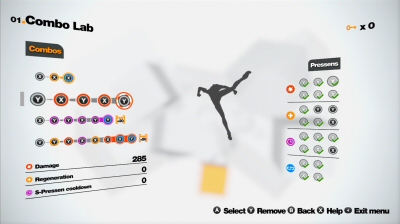
As the game progresses, the player unlocks the two longer combos and more Pressens become available to populate them; unfortunately, you start out with next to nothing which means you have to scrape by in the early episodes.

As you land hits, the buttons show up on screen making the combos a no-brainer to execute. And the Pressens are color coded so you can see at a glance this particular combo does a little bit of everything.
Review by Jay Wilson This is one of those games where you really want to see a sequel: a game with great ideas but the execution just never delivers. Every aspect feels rudimentary at best—not bad, just undeveloped. You take control of Nilin Cartier-Wells, a Memory Hunter, as she recovers from imprisonment, exploring Neo-Paris while piecing together her tattered memory by ripping them straight out of minds of those who stole them in the first place. And let’s take the setting for example: a wonderfully colorful cityscape with buildings to climb, balconies to jump off from, and rooftops to battle on ... but there’s never any sense of exploration. No secret tunnels that serve as shortcuts, no shady street dealer who could offer additional power ups (or memories that could open up hidden abilities), almost no mid-battle hazards from the environment despite one fight taking place over an abstract bottomless abyss. It’s point A to point B with no chance of getting lost, no NPC interactions except with the handful of characters that drive the main plot, and no real mix-ups to keep the combat fresh and engaging. Now, I don’t have a problem with more focused games as opposed to open ended ones that allow you to wander and do anything (or nothing)—I actually prefer focused games that do not permit much veering from the main objective—but ideally that game should suggest more exists beyond points A and B. The scope of the game should be saving the world because that’s the most interesting part, but once it ends and the pressure is off, you should be able to imagine the protagonist going back to the bar in Episode III for a beer and a night off. But Remember Me, by contrast, is so focused that even though Episode III has a bar (the awesomely named “Leaking Brain”) which Nilin does indeed defend, I can’t imagine it as anything except one in a long string of if/then statements awaiting user input. Push Enter to continue. Granted, in games like Super Metroid, Symphony of the Night, and Mario Bros. 3 (all very focused, non-open ended, games) I can’t imagine the protagonists hanging out in the levels after the fact, but those games also don’t try to be movies. And with that said, why are there still unskippable cutscenes in 2013? Seriously?! This damn near makes Remember Me unplayable a second time around. And keep in mind, I like this game. I really like this game. Hell, on my first playthrough, I was so willing to immerse myself in this exotic imagining of a futuristic Paris, I took my time and had Nilin walk everywhere instead of run (the default) because, you know, realistically grown adults don’t dart around from place to place at top speed. I was happy to casually peruse, sight see, read the helpful gameplay tips, and watch the story unfold. But, you know what? When I play a second time, it’s only for the gameplay. I already know what’s going to happen, why it happens, and how to do everything. Now I just want to race to the next battle, breeze past the tutorial text, and skip the god damn cutscenes. 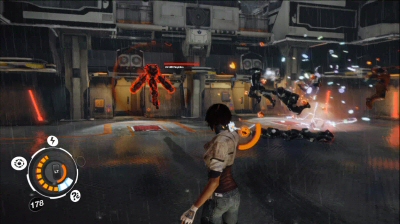
The orange arc in the lower left corner indicates the spammer’s readiness to fire. The yellow blocks represent Nilin’s life. Light blue blocks are her Focus which allows usage of available S-Pressens (the round white icons). And the timer displays the cooldown of a recently used S-Pressen (the explosion to the right).
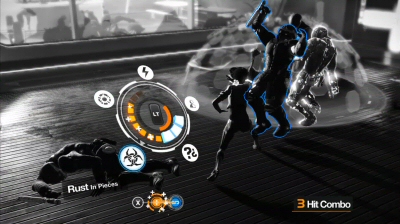
The game de-facto pauses when you bring up the radial S-Pressen menu, allowing you to select these devastating attacks at your leisure. Some S-Pressens affect Nilin, some affect all creatures, and some require you to pick a target.
But I do like Remember Me. In particular, I love its battle system. I love the cinematic flow of the fights as Nilin combos the crap out of an enemy while others swarm around her, then right as the army prepares to pounce she cancels out of an attack and dodges—flipping over her prey’s head—to finish him off with an airborne slow-motion scissor kick. I love that the game indicates an incoming attack (even off screen) with a red exclamation point, letting you know to put your combo on hold. I love the fast paced brutality of the memory overloads as Nilin smashes bad guys into a wall, shreds their mind, and throws them to the floor. And adding to the action film feel, let’s not forget the powerful orchestral music (richly enhanced with digital sound effects) that follows the fight, dwindling down to just basic percussion and rhythm while circling foes and selecting targets only to climax into a dramatic crescendo as Nilin engages. But as much as I like the combat, it still could have been much much better. Our Memory Hunter protagonist gets a ranged attack (the spammer) and four blank melee combos ranging from three to eight hits. You then populate those combos with specific types of attacks called Pressens—damage, regeneration, cooldown, and chains. As its name implies, Damage Pressens deal heavy damage and also break an enemy’s guard; Regeneration Pressens heal Nilin. Cooldown Pressens reduce the time it takes for super moves (S-Pressens) to recharge. And Chain Pressens takes the previous Pressen and multiplies its result. Thus you can create a combo that gets Nilin back up to full life in one go; you can create another combo that instantly recharges her supers; or you can create a combo that uses a bit of everything—healing Nilin while cooling down S-Pressens and dealing damage all in moderation. Slick idea. I like it. Now I don’t have to waste time in an inventory screen. The down side? The game clearly favors loading up a combo with the same type Pressen to create the aforementioned hyper-focused healing combos (or instant S-Pressen rechargers or ultra powerful pure damage combos). You can get away with mish-mash combos that do a little of everything, but you’ll hate yourself during the boss fights when only one S-Pressen can hit ‘em and you have to wait for the timer to get down from one-hundred and eighty before you can use it again. And even when you do stack up the cooldown Pressens and can reset the super in under fifteen seconds, the boss fights still drag on with tedious monotony because there’s only one way to fight each boss ... and that one way requires killing endless fodder/minions to charge up Nilin’s Focus meter (super meter), executing the S-Pressen, and then killing endless fodder/minions to cool down said S-Pressen. Then you get to repeat the process at least twice more because none of the bosses go down after one shot. In other words, you spend 75% of the boss battle not battling the boss which feels like a waste of time. It’s a damn good thing the dodge is God-like. 
After defeating each boss in the real battle, the game switches to a brief series of quick time events to cinematically finish them off.
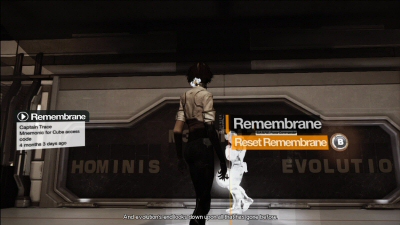
After stealing someone’s memory, Nilin can activate Remembranes and glimpse into their past which provides necessary information for advancing beyond arbitrary obstacles.
One saving grace is that Nilin retains her Focus until discharged (or death), and across the game she gains the ability to store multiple blocks of Focus so you can go into a boss fight and immediately unleash an S-Pressen and be ready to unleash three more as soon as it cools down. Unless the boss kills you. Then it’s back to charging up, cooling down, charging up, cooling down, charging up ... And although nowhere near as bad, some of the lesser enemies annoyingly limit your options as well. For example, starting in Episode V Nilin faces Sabre Soldiers with electrified armor which hurts her when she hits them. Very cool. That’s actually a good idea. It forces you to be wary of engaging them. The problem is it doesn’t discourage one form of attack or another—say melee versus ranged—it discourages all attacks. S-Pressens aside, the only way to engage these guys is by using combos loaded up with Regeneration Pressens, and there’s no good reason for it. Why can’t I have the option of running in with a healing combo OR safely shooting from a distance? There’s nothing wrong with strategically narrowing the player’s options in key scenarios; in fact, it actually makes the game more interesting—more engaging—by encouraging variety and creativity while simultaneously discouraging button mashing autopilot. You know what else? It also lets the player switch up his strategy, bouncing back and forth between valid and effective tactics which, by the way, combats monotony. It doesn’t take a million options to get there. Hell, give me two. That’s all I need to make a choice. Remember Me’s greatest strength is its central premise. Memorize, the standard antagonistic mega-corporation, has found a way to monetize memory manipulation, wiping away unpleasant memories from its clients. And Nilin, a memory hunter, has mastered the art of stealing and altering memories, allowing her to pull vital information out of guard captains to thwart security protocols and make allies out of former enemies. In gameplay terms, this translates to Remembranes which, at the push of a button, triggers non-intrusive quasi-cutscenes that play out without hijacking the controls away from the player. For example, coming upon a mine field, Nilin can trigger a Remembrane from a character who successfully navigated the hazardous terrain, and now she can follow the memory in real time to make it through, herself. And then there’s the memory remixes, an interactive cutscene showing a critical moment in that character’s past, and Nilin is given a specific objective: to alter the memory in such a way that it influences their attitude in the present. 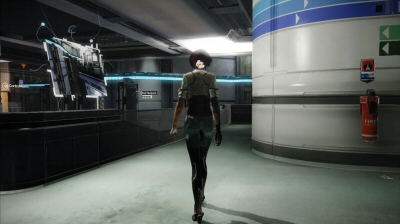
Along the way, these floating screens (left) will materialize showing the location of a nearby collectible item which, after collecting enough, increases the number of health blocks and focus blocks Nilin has which, of course, helps her in fights.
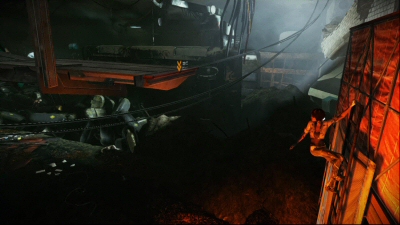
Note the yellow arrows over the catwalk, indicating where Nilin can jump to. Also note there’s nowhere else to go ...
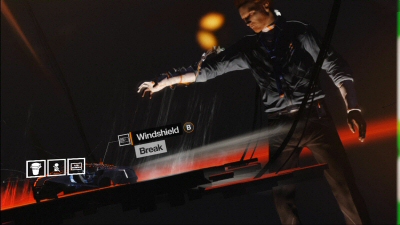
I really didn’t care for the remix mechanics. It’s a cutscene you can fast forward and rewind through, and at key points you can click on one of the preset objects to change with preset results. Fortunately, they’re mercifully few and far between.
And it’s here that Remember Me brushes up with science fiction—real science fiction—even if the game does not fully embrace it. Science Fiction poses questions and provokes thought by following the answers out to their logical conclusions with meticulous detail. Are we just the sum of our memories? And could a person with the power to re-shape our perception of the past also reshape our personalities, our outlook, and our motives? Unfortunately, once again, Remember Me never fully explores these fascinating possibilities. The game implies Nilin alters memories with scalpel precision, but do those changes ripple through all other dependant memories? As time passes we gain more memories so if a loved one died twenty years ago, that’s twenty years worth of memories dealing with the loss. Is it possible, then, for Nilin to cause a memory conflict? And if so, how does the subject react? Could it drive someone to an emotional breakdown? To insanity? What about physical evidence? Nilin can alter memories all she wants, but the actual events leave a trail of hard concrete undeniable proof that the memory is false. How do people reconcile these drastic differences? From here, a more thoughtful narrative would transition into social commentary: observing how people often accept their abstract memory over the unforgiving facts. But the closest Remember Me comes is the memory bugs—a subject dying in their own memory—which yields a prompt telling you to rewind and remix again. It never takes advantage of the possibilities offered by its premise; it never quite reaches that harmonious balance of challenging but fair gameplay; and it never fleshes out its derivative yet inspiring setting, characters, and story arc. And so, while I do like Remember Me, I can never quite fall in love with it. Oh well, here’s to a sequel ... | ||||||||||||||||||||
|
| ||||||||||||||||||||
